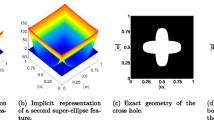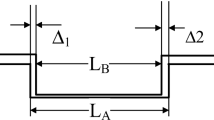Abstract
In this paper, an approach based on kinematic method for solving 3D geometric assembly constraints is presented. The relative generalized coordinates and generalized recursive formulations used in kinematic analysis are utilized to reduce the size of constraint equations. Based on the cut-constraint method, this approach can be used to solve all kinds of configurations. In the case of an open-loop constraint system, the geometric constraints can be satisfied by sequentially determining the values of relative generalized coordinates. With respect to a closed-loop constraint system, the proposed approach converts it to a spanning tree structure by cutting constraints and introducing cut-constraint equations. Furthermore, a topological analysis method is also developed to obtain the spanning tree with the minimal number of cut-constraint equations, and the analytical Jacobian matrix of cut-constraint equations is derived to enhance computational efficiency. In the end, the proposed approach is demonstrated and validated using two examples of closed-loop geometric constraint system.
Similar content being viewed by others
References
Kim J, Kim K, Lee JY, Jung HB (2004) Solving 3D geometric constraints for closed-loop assemblies. Int J Adv Manuf Technol 23:755–761
Peng Xb, Lee KW, Chen LP (2005) A geometric constraint solver for 3D assembly modeling. Int J Adv Manuf Technol 28:561–570
Dohmen M (1995) A survey of constraint satisfaction techniques for geometric modeling. Comput Graph 19(6):831–845
Ligh R, Gossard D (1982) Modification of geometric models through variationional geometry. Comput Aided Des 14(3):209–214
Sutherland I (1963) Sketchpad, a man-machine graphical communication system. Proc spring joint comp conference, North Holland, pp 329–345
Ge JX, Chou SC, Gao XS (1999) Geometric constraint satisfaction using optimization methods. Comput Aided Des 31(14):867–879
Chou SC (1987) Mechanical geometry theorem proving. Kluwer, Dordrecht
Aldefeld B (1988) Variation of geometries based on a geometric-reasoning method. Comput Aided Des 20(3):117–126
Owen J C (1991) Algebraic solution for geometry from dimensional constraints. Proc ACM Symp Found of solid modeling, Austin, TX, pp 397–407
Bouma W, Fudos I, Hoffmann CM, Cai J, Paige R (1995) Geometric constraint solver. Comput Aided Des 27(6):487–501
Hoffman CM, Vermeer P (1995) Geometric constraint solving in R2 and R3. In: Computing in Euclidean geometry. World Scientific, Singapore, pp 170–195
Li YT, Hu SM, Sun JG (2002) A constructive approach to solving 3D geometric constraint systems using dependence analysis. Comput Aided Des 34:97–108
Kramer GA (1992) Solving geometric constraint system: a case study in kinematics. MIT Press, Cambridge
Haug EJ (1989) Computer aided kinematics and dynamics of mechanical systems: Basic method. Allyn and Bacon, Boston
Hong JZ (1999) Computational dynamics of multibody system. Higher Education Press, Beijing
Bae DC, Haug EJ (1987) A Recursive formulation for constrainted mechanical system dynamics, Part II–closed loop systems. Mech Struct Mach 15(4):481–506
Zou H, Ko AM, Wang JY (1996) Computer-Aided design using the method of cut-joint kinematic constraints. Comput Aided Des 28(10):795–806
Tsai FF, Haug EJ (1991) Real-Time Multibody systems Dynamic Simulation: Part I. A modified recursive formulation and topological analysis. Mech Struct Mach 19(1):99–127
Bae D S, Lee JK, Cho HJ, Yae H (2000) An explicit integration method for real-time simulation of multi-body vehicle models. Comput Methods Appl Mech Eng 187:337–350
Author information
Authors and Affiliations
Corresponding author
Rights and permissions
About this article
Cite this article
Xia, H., Wang, B., Chen, L. et al. 3D geometric constraint solving using the method of kinematic analysis. Int J Adv Manuf Technol 35, 711–722 (2008). https://doi.org/10.1007/s00170-006-0748-3
Received:
Accepted:
Published:
Issue Date:
DOI: https://doi.org/10.1007/s00170-006-0748-3




